Weevils
What are Weevils?
These fancy-named creatures are nothing but beetles. They belong to the Curculionidae family. These small sized insects are called as Weevils that grow about 0.24 inches in size and are herbivores by nature. Did you know as many as 9700 species of this creature alone walk the Earth? They are not only a part of one family but belong to several other families like the Curculionidae (which sees the majority number of Weevils). There is a weevil with a funny and quite creative name, “biscuit weevil.” They have the power to damage and ruin crops, and that is why a weevil is regarded as a dangerous pest.
Today, we shall be talking about Weevils and inform you all about them. So, get ready to learn all the intricate details about this bug.
What do Weevils look like?
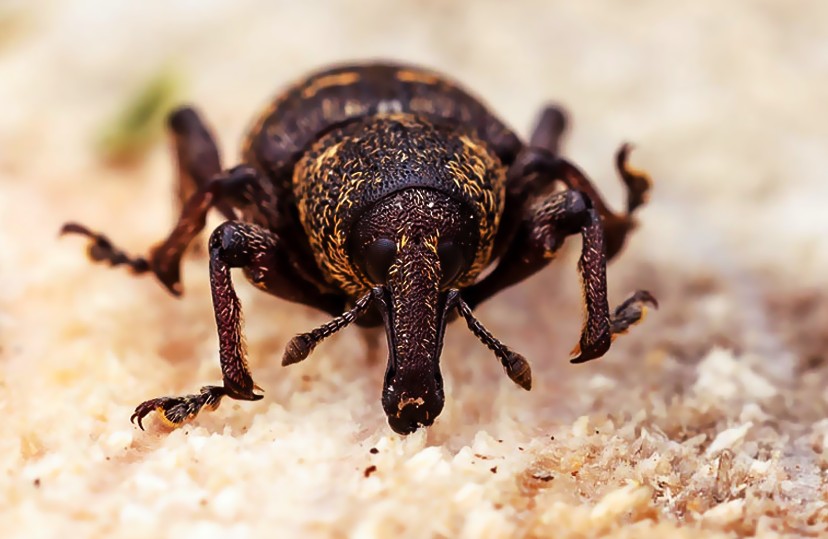
Picture of a Weevil
A weevil is a beetle that can be found in a wide range of colors and sizes. Mainly they have an oval body shape, or they are slender looking. The species of the weevil defines its length. They can be either 3mm long or as big as 10 mm.
Weevils usually have a dark colored body that ranges from brown to black. You can clearly understand whether the beetle is a Weevil by seeing its head. The adult weevil has an unusually elongated head that resembles a snout. This can be as big as their own body. The mouth of the weevil lies at the end of the snout. Different species have different appearances. The Bruchidae species lack the snout and don’t resemble the original weevil.
Types of Weevils with Pictures
It is very easy to identify a weevil; their famous snout gives them away. Their color can vary from black to grey to a combination of reddish and brown. They have a distinguishing trait that is the two spurs that are present on the femur (first joint) of each of their front legs. The Weevils family contain more than 60,000 species under the name of Curculionoidea. As many as 1000 of these species are found in North America alone. A Weevil may also contain shiny body hair or scales on its body. The snout beetles have spurs on their front legs. There are 9 types of Weevils.
Boll Weevil
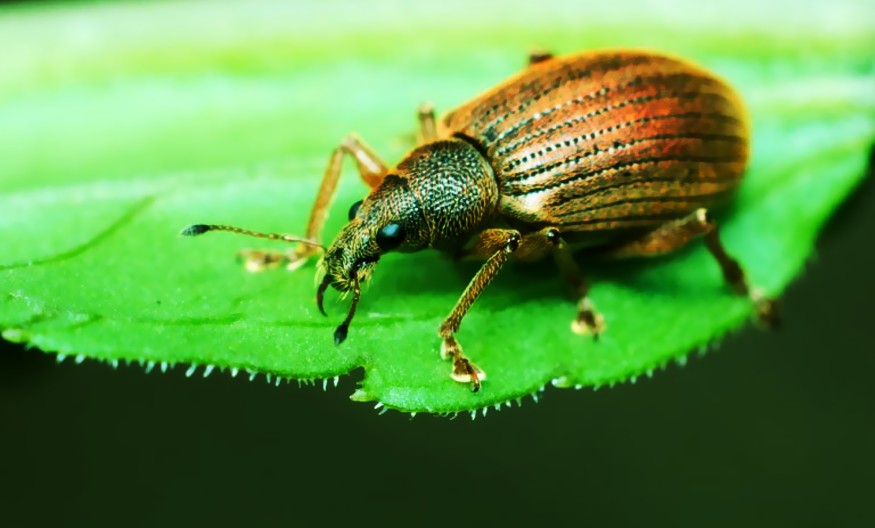
Picture of Boll Weevils
These feed themselves on cotton plants and buds. They are usually 6 mm in length. The Boll Weevils love the little balls of cotton plants and reduce the fiber content of plants. Before they go into hibernation, they produce several generations.
Flour Weevil

Picture of Weevils in Flour
They are not a Weevil. These belong to the Tenebrionidae family. They have an oval, 4 mm long body. Their body shows a combination of reddish-brown and metallic color. They relish on stored food as well as flour. Powdered milk, cake mix, and cornstarch are other preferred food of these Weevils.
Rice Weevil

Picture of Rice Weevils
They have a reddish brown colored body and have wings. The size of the rice weevil is about 4 mm. They have an elongated snout and feast on every kind of grain.
Bean Weevil
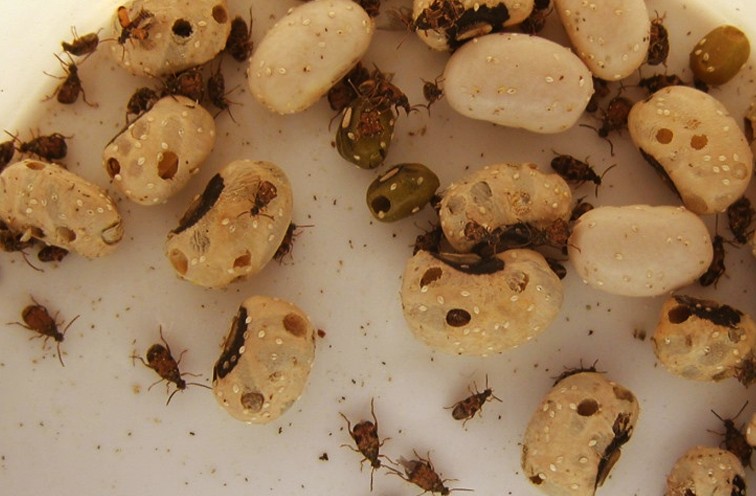
Picture of Bean Weevils
These are the seed beetles. They have a round body in comparison to the other Weevils. The bean weevils lack the famous snout. They possess a hairy, olive green color body with dark wings. The bean weevils survive on lentils, seeds, and cowpeas.
Wheat Weevil
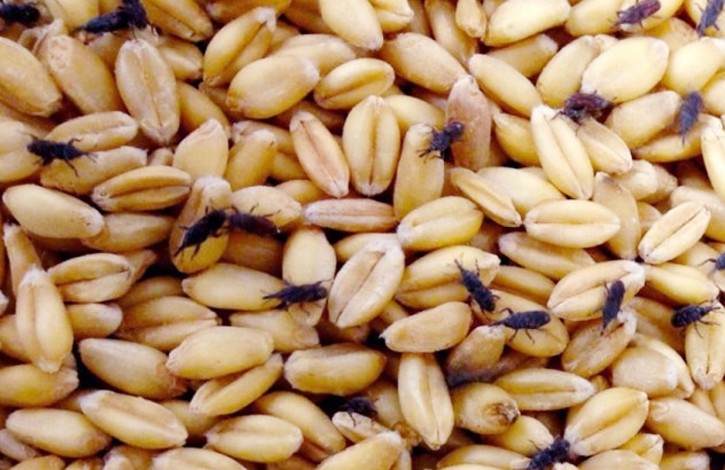
Picture of Wheat Weevils
These go by the name granary weevil and can be a nightmare to farmers. Their body size is smaller than 5 mm, and it is dark brown in color. They have patterns made on their heads and lack wings.
Black Vine Weevil
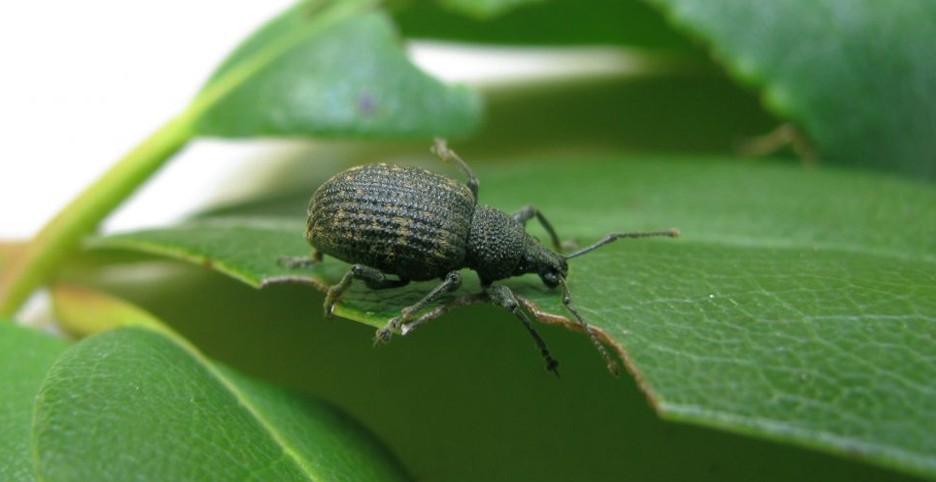
Image of Black vine Weevils
These are basically found in Ohio, a state in the northern region of the United States of America. The black vine weevil diet comprises of herbs, shrubs, trees, and other plants. The larvae of these weevils prefer different food than their adults.
Rose Weevil

Rose Weevils Image
These weevils are a combination of black and red and are usually 6 mm in length. They have a very prominent head and snout. Rose weevil make holes in buds of different flowers. They don’t leave behind the shoots or stems of plants.
White Pine Weevil

White Pine Weevil Picture
A combination of white and brown color weevils that grow about 7mm. This color is present all over their wings. They feed on pine trees however they don’t leave out spruce and pole pines.
Cowpea Weevils
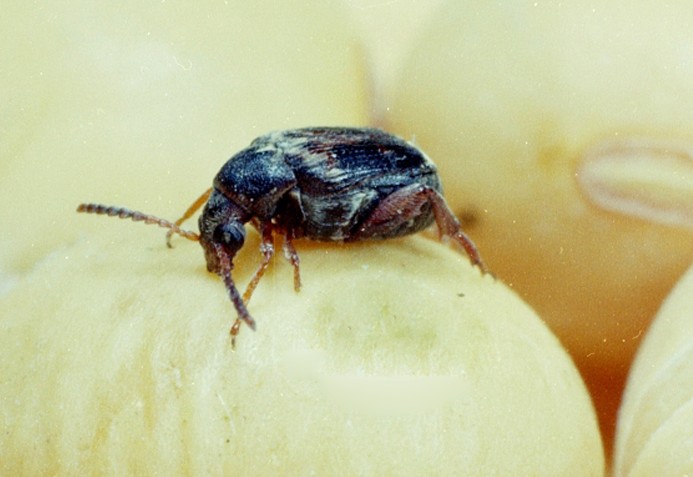
Picture of Cowpea Weevils
This reddish-brown Weevil with black or gray marks don’t have the typical weevil snout. They consume soybeans.
Weevils in flour
These weevils are a type of beetles that feed on flour and are found in it. They belong to the Tenebrionidae family. Flour weevils lack the ability to consume whole grains.
Are Weevils dangerous?
They are usually found in grains, specially packaged food items like cereals, flour, and cornmeal. The adults lay eggs in the food. They possess no threats to humans or pests. Yes, it is plain gross to find beetles that too one with a snout walking in your food, however, they can’t harm you. They possess threats to food producers.
Signs of Weevil Infestation
If you see a lot of damages to your grains or food products, then it is the work of a Weevil. They cause a lot of damage to grains, macaroni, wheat, oats, corn, sorghum, barley, buckwheat, Kaffir seed, and other products. These products are mostly damaged by Weevils. Look for signs to know whether you have them.
How to get rid of Weevils?
They are creepy, disgusting, and most importantly they invade your food. Once they get a chance to enter your pantry, your food items are in threat. Rice, dry fruits, flour, baby food, nuts, milk powder, and so on. It is very important you deal with them as soon as possible because they will multiply and that too in your food. Do you want that? The second you locate signs of infestation get ready to deal with them.
Start cleaning your pantry
The first way to deal with weevils is by cleaning your pantry. These pests always stay near your food, which means closer to your pantry. If you spot small brown or red colored creatures moving in your dry food, know that it is a Weevil. Check for these near your pet’s food dishes, which can be a primary source of their food. Look for it in grains, oats, quinoa, rice, bran, herbs, spices, dried fruits, dried pasta, beans, nuts, candy, chocolate, and dried peas.
If you find any weevil, simply throw that food away. They lay eggs in food, and it will multiply in no time.
Start vacuuming
Start cleaning the shell on which you store your dried food items. There should be no flour or bits of other food items lying around. Using a cloth wipe the shelves after dipping it in hot water and dishwashing soap. There should be absolutely no food around your kitchen shelves or counter.
The use of eucalyptus
After cleaning the shelves use a mixture of water and vinegar (equal quantities) to wipe the shelves. You can even use eucalyptus oil after diluting it with some water. Spray it all over the kitchen shelves. Pine needle oils, neem oil, and cedar oil are also very beneficial.
Use airtight containers
You should store all your food in airtight containers. It is not a good option to leave them in cardboard boxes that makes it very easy for the weevils to invade your pantry. Store everything in hard and air-tight boxes. This is also applicable for muffin and cake mix.
Don’t buy more than you need
Buy small amounts of flour each time. If you are not using it on a daily basis it is advisable to buy only a small amount each time. Unused flour attracts weevils, they invade it and turn it into their home. When you use freshly bought flour, the chances of infestation reduce.
Use the freezer
Weevils might be present in the flour at the time you bought them. You can take care of this problem by freezing the flour. In a ziplock bag pour the flour and place it inside the freezer. Let it stay there for as long as a week, even more, if you don’t need it. This will eliminate all the Weevils and their eggs. After freezing it pour it in an airtight container and then place it on your kitchen shelf.
Trick the buggers
You can buy a trap to get all the Weevils that are present in your home. These traps come with a sticky space and use pheromones to attract the Weevils. Place them around your kitchen, on the shelves, and pantry. Checking your pantry on a day to day basis is a good idea too.
When the infestation of Weevils is beyond control, you should leave matters in the hands of professionals. They are a serious nuisance and even though they don’t bite or harm you, they shouldn’t be in your food. Take the necessary steps today to deal with it.
